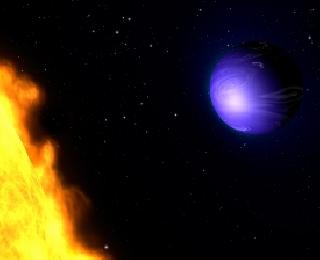
An artistic illustration of HD 189733b orbiting its yellow-orange star, HD 189733. A NASA, ESA and G. Bacon (STScI) photo
WASHINGTON (BNS): Astronomers have come across an exoplanet emitting deep blue colour -- a trait similar to Earth when seen from space.
The exoplanet, HD 189733b, is orbiting its host star 63 light-years away, and thus is one of the closest exoplanets that can be seen crossing the face of its star.
The astronomers, while making visible-light observations using NASA's Hubble Space Telescope, have deduced the actual colour of the planet as deep blue.
The telescope's Imaging Spectrograph measured changes in the colour of light from the planet before, during and after a pass behind its host star. There was a small drop in light and a slight change in the colour of the light.
"We saw the light becoming less bright in the blue but not in the green or red. Light was missing in the blue but not in the red when it was hidden," said research team member Frederic Pont of the University of Exeter in South West England.
"This means that the object that disappeared was blue."
HD 189733b's blue hue, however, is the sole similarity it has with our home planet Earth.
The exoplanet is among a bizarre class of planets called 'hot Jupiters', which orbit precariously close to their parent stars. The planet is only 2.9 million miles from its parent star -- so close that it is gravitationally locked. One side of it always faces the star while the other side is always dark.
The planet's close proximity to its host star results in the daytime temperature on this alien world soaring up to 2,000 degrees Fahrenheit, and it possibly rains glass -- sideways -- in howling, 4,500-mph winds.
According to the researchers, the cobalt blue colour of the planet comes not from the reflection of a tropical ocean as it does on Earth, but rather a hazy, blow-torched atmosphere containing high clouds laced with silicate particles. Silicates condensing in the heat could form very small drops of glass that scatter blue light more than red light.
Hubble and other observatories have made intensive studies of HD 189733b and found its atmosphere to be changeable and exotic. The planet was discovered in 2005.
The latest observations provide new insights into the chemical composition and cloud structure of the entire class of hot Jupiters. Detecting the presence and importance of clouds in hot Jupiters is crucial to astronomers' understanding of the physics and climatology of other planets, NASA said.
 Previous Article
Previous Article Next Article
Next Article













The Indian Air Force, in its flight trials evaluation report submitted before the Defence Ministry l..
view articleAn insight into the Medium Multi-Role Combat Aircraft competition...
view articleSky enthusiasts can now spot the International Space Station (ISS) commanded by Indian-American astr..
view article